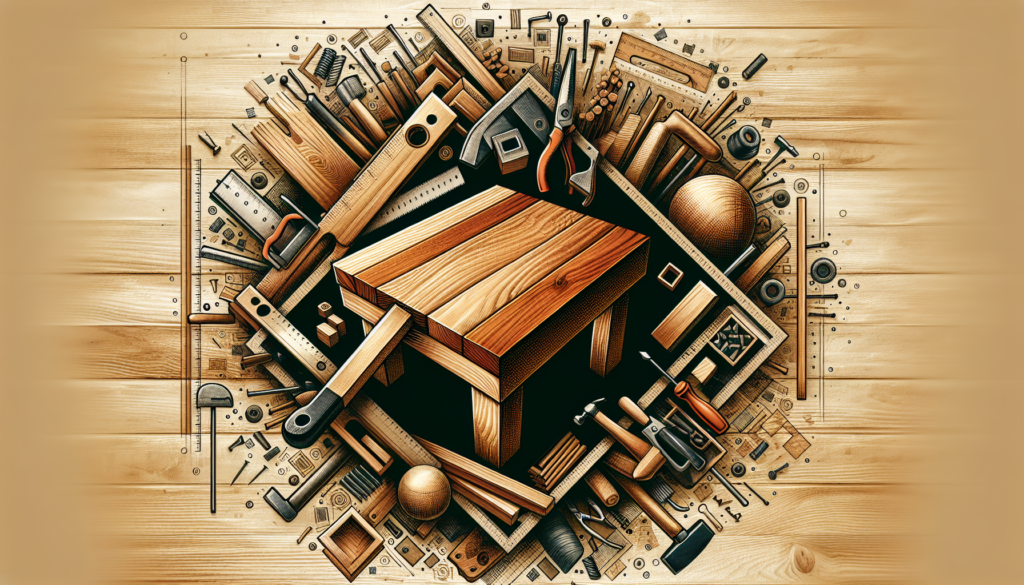So, you’ve been wanting to build a simple wooden desk, but you’re not quite sure where to start? Don’t worry, you’re in the right place! In this article, we’ll guide you through the step-by-step process of building your very own wooden desk, from choosing the right materials to assembling the final product. Whether you’re a beginner or an experienced DIY enthusiast, we’ve got you covered. So, roll up your sleeves and get ready to unleash your inner carpenter!
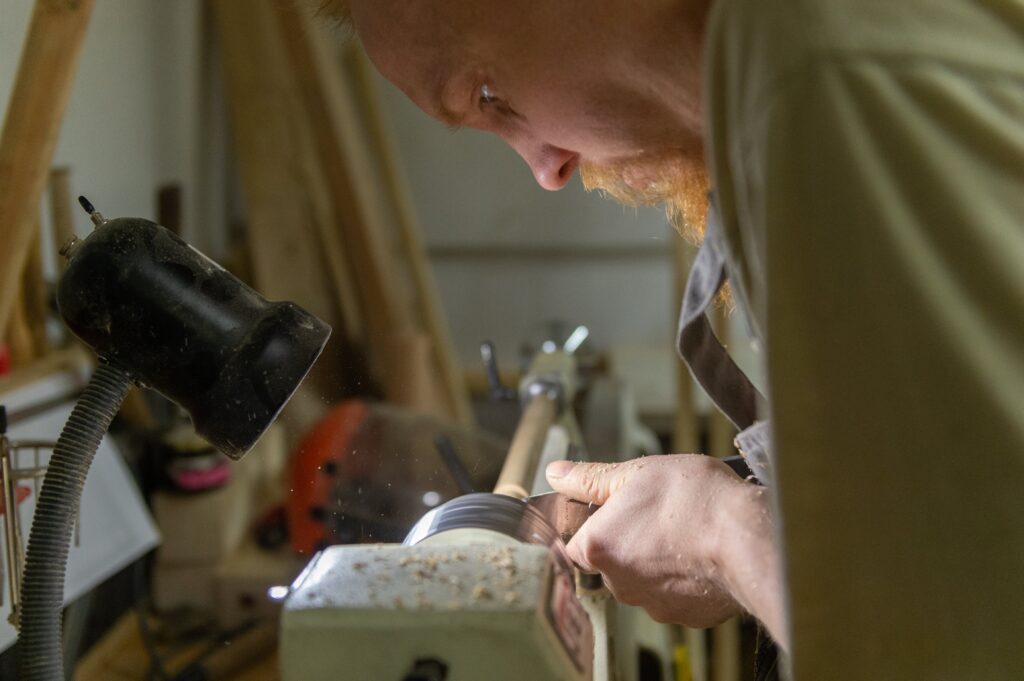
Choosing the Right Wood
When it comes to building a wooden desk, choosing the right type of wood is one of the most important decisions you will make. The type of wood you choose will not only affect the aesthetic appeal of your desk but also its durability and longevity.
Determining the Desk Size
Before you start selecting your wood, it is vital to determine the size of your desk. Consider the space available in your room and how the desk will fit into it. Measure the area where you plan to place the desk and keep in mind any additional features or storage options you may want to incorporate.
Considering the Wood Species
Different wood species have unique characteristics and appearances. Some popular options include oak, maple, walnut, and pine. Oak is known for its durability and attractive grain patterns, while maple offers a smooth and elegant finish. Walnut is favored for its rich, dark color, and pine is a more affordable choice with a versatile look. Consider the style you want to achieve and the level of maintenance required for each wood species.
Evaluating the Wood Quality
When selecting your wood, it’s important to evaluate its quality. Look for straight and smooth pieces without any visible knots or cracks. Ensure that the wood is properly dried and has a consistent color throughout. You can also check for the wood’s density and hardness to determine its overall durability. Investing in high-quality wood will ensure that your desk lasts for years to come.
Gathering the Necessary Tools and Materials
To build your own wooden desk, you will need a few essential tools and materials. Here’s a list of what you’ll require:
Measuring Tape
Accurate measurements are crucial for a well-fitted desk. A measuring tape will help you determine the dimensions of your desk components and ensure everything fits together seamlessly.
Circular Saw
A circular saw is a versatile power tool that will make cutting the wood to size much easier. Make sure to use the appropriate blade for your chosen wood type to achieve clean and precise cuts.
Drill
A drill is essential for creating holes, attaching screws, and assembling the different components of your desk. Invest in a high-quality drill with different drill bit sizes to accommodate various screw sizes.
Screws
Choose screws that are appropriate for the thickness of your wood and the type of joints you will be using. Make sure to have a variety of sizes on hand to accommodate different parts of your desk.
Wood Glue
Wood glue is essential for providing additional strength and stability to your desk joints. Opt for a high-quality wood glue that dries clear and has a strong bond.
Sandpaper
Sanding is a critical step in achieving a smooth and polished finish. Invest in different grits of sandpaper to help you achieve the desired level of smoothness on your desk surface.
Wood Stain or Paint
Adding a wood stain or paint to your desk can enhance its appearance and protect the wood from damage. Choose a stain or paint color that complements your room’s decor and personal preferences.
Protective Finish
A protective finish, such as polyurethane or varnish, will help safeguard your desk from scratches, moisture, and daily wear and tear. Select a finish that is compatible with your chosen wood type and follow the manufacturer’s instructions for application.
Designing the Desk
Once you have gathered all the necessary tools and materials, it’s time to bring your vision to life by designing your desk.
Choosing a Desk Style
Consider the overall style of your room and select a desk style that complements it. Whether you prefer a rustic farmhouse look or a sleek modern design, there are numerous desk styles to choose from. Take inspiration from existing furniture or explore online resources for design ideas.
Sketching the Design
Before diving into the construction process, it is beneficial to sketch your design on paper. This will help you visualize the dimensions and layout of your desk, ensuring that everything fits together harmoniously. Include details such as leg placement, storage options, and any other features you wish to incorporate.
Determining Dimensions
Based on the available space and your design preferences, determine the dimensions of your desk. Consider the height, width, and depth of the desktop, as well as the size and positioning of any additional features or storage areas. It’s important to strike a balance between functionality and aesthetics.
Creating a Cut List
With your design and dimensions finalized, create a cut list that outlines the specific measurements for each piece of wood needed. This will serve as your guide and help streamline the cutting and assembly process. Make sure to double-check your measurements before making any cuts.
Preparing the Wood
Once you have a clear plan in place, it’s time to prepare the wood for construction.
Gathering the Required Wood
Refer to your cut list and gather the necessary wood pieces according to the measurements. Double-check that you have the correct type and quantity of wood before proceeding.
Cutting the Wood to Size
Using your circular saw, carefully cut each piece of wood to the dimensions specified in your cut list. Take your time and ensure that your cuts are straight and accurate for a professional-looking finished product.
Smoothing the Edges
After cutting the wood, use sandpaper to smooth out any rough edges or splinters. This will create a nice, finished look and prevent any potential injuries when handling the wood.
Drilling Holes if Needed
If your desk design requires any holes for screws or connecting components, drill them at this stage. Use a drill bit that matches the size of the screws you will be using and ensure that the holes are straight and clean.
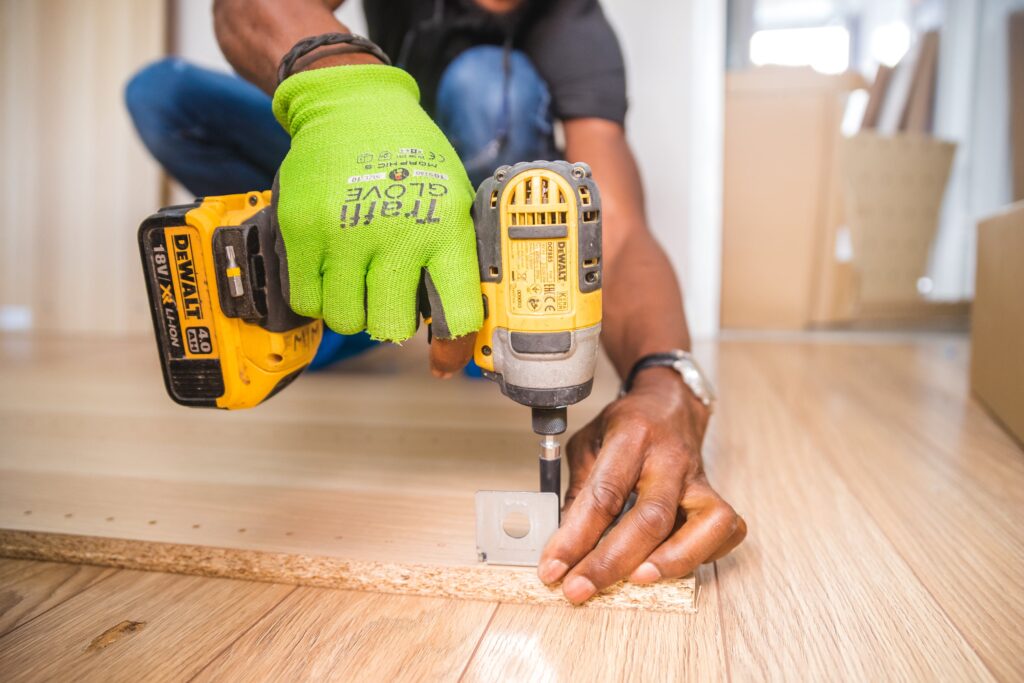
Assembling the Desk
Now that your wood is prepared, it’s time to start assembling your desk.
Laying Out the Desk Components
Organize your desk components according to your design plan. Lay them out on a clean and flat surface, ensuring that all pieces are easily accessible during the assembly process.
Attaching Legs and Supports
Start by attaching the legs and any additional support structures to the desk frame. Use screws and wood glue to secure them in place, following your design and ensuring everything is square and level.
Securing the Desktop
Once the frame is complete, carefully position the desktop on top and secure it to the frame using screws and wood glue. Ensure that it is centered and flush with the edges of the frame.
Adding Drawers or Shelves if Desired
If your design includes drawers or shelves, now is the time to install them. Follow the manufacturer’s instructions or use your design plan as a guide to ensure proper installation and alignment.
Sanding and Finishing
With the desk assembled, it’s time to sand and finish the wood to achieve a beautiful and durable surface.
Sanding the Entire Desk Surface
Using your sandpaper, gently sand the entire desk surface. Start with a coarser grit sandpaper to remove any rough spots or imperfections, then gradually move to a finer grit to achieve a smooth finish. Sand in the direction of the wood grain to prevent damage.
Applying Wood Stain or Paint
If you choose to stain or paint your desk, follow the manufacturer’s instructions for proper application. Apply even coats of stain or paint using a brush or roller, ensuring that each coat is dry before applying the next.
Allowing Sufficient Drying Time
After staining or painting, allow the desk to dry completely. This usually takes several hours, but refer to the product instructions for specific drying times. Avoid placing any objects on the desk during this time to prevent smudges or damage to the finish.
Adding Protective Finish
To protect your desk from everyday use, apply a protective finish such as polyurethane or varnish. Follow the manufacturer’s instructions for application, ensuring that the finish is evenly spread and coats all exposed surfaces. Allow sufficient drying time between coats, and sand lightly between coats for a smooth and professional finish.
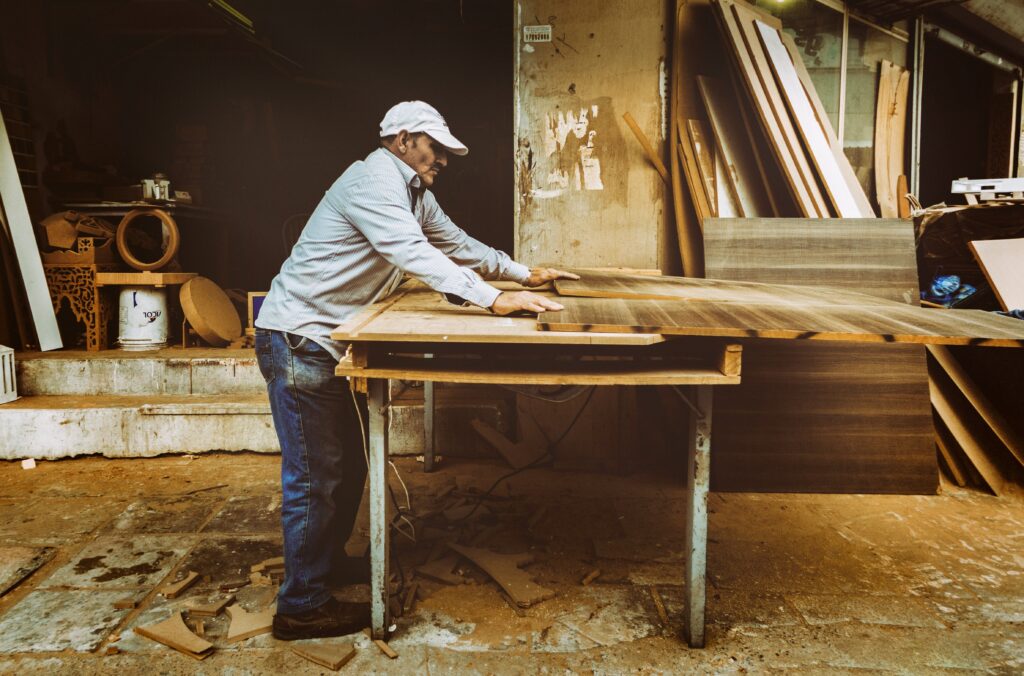
Adding Additional Features
To further enhance the functionality and convenience of your desk, consider adding some additional features.
Wire Management
Keep your desk organized and free of tangled wires by incorporating wire management solutions. These can include cable clips, grommets, or even built-in wire management systems.
Keyboard Tray
Maximize your comfort during long hours of work by adding a sliding keyboard tray. This will help keep your desktop clutter-free and provide an ergonomic typing position.
Cable Organizers
Invest in cable organizers like cable sleeves or cable ties to keep your cables neat and tidy. This will prevent them from becoming tangled and tripping hazards.
Built-in Power Strip
Create a clean and efficient workspace by installing a built-in power strip. This will provide easy access to power outlets for all your electronic devices without the clutter of loose cables.
Troubleshooting and Tips
While building your wooden desk, you may encounter a few challenges along the way. Here are some common troubleshooting tips:
Fixing Misaligned Parts
If you discover that certain parts of your desk are misaligned, double-check your measurements and make necessary adjustments. Use clamps or additional screws to hold the parts in place while you make any necessary corrections.
Repairing Surface Imperfections
If you notice any surface imperfections or scratches, they can often be fixed with a little sanding and touch-up stain or paint. Take your time to blend in the repaired area seamlessly with the rest of the desk surface.
Applying Even Finishing
To achieve an even finish, take care to apply your stain or paint in thin and even coats. Avoid overloading the brush or roller, as this can result in drips or uneven coverage. Make sure to follow the recommended drying times between coats.
Balancing Uneven Legs
If you notice that your desk wobbles or has uneven legs, try adjusting the position of the legs or use furniture pads to level the desk. This will provide a stable and safe surface to work on.
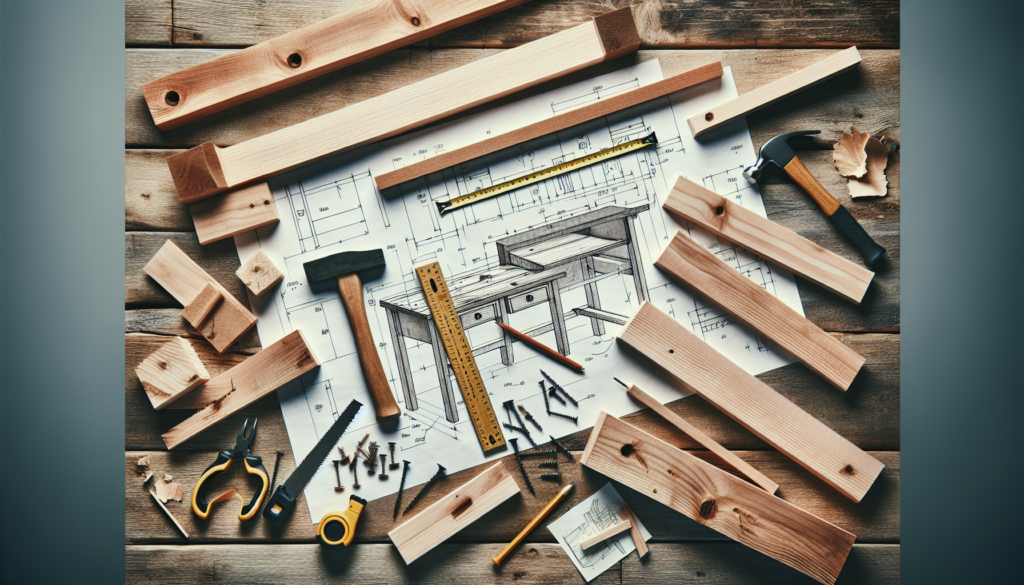
Customizing the Desk
Building your own wooden desk provides an opportunity for customization and personalization. Consider these ideas to make your desk truly unique.
Choosing Alternative Wood Finishes
Explore different wood finishes such as distressed, whitewashed, or reclaimed looks to give your desk a unique and customized appearance. Experiment with different stains or paints to achieve the desired effect.
Adding Personal Touches
Incorporate your personal style by adding small details or embellishments to the desk. This could be as simple as adding decorative hardware, carving initials, or attaching personalized nameplates.
Incorporating Different Desk Shapes
While rectangular desks are the most common, consider alternative desk shapes such as L-shaped or corner desks. These designs maximize workflow and provide additional surface area.
Exploring Creative Modifications
Get creative and think outside the box. Consider adding built-in bookshelves, a sliding whiteboard panel, or even a hidden compartment for extra storage. The possibilities are endless.
Maintaining and Care
To ensure your wooden desk stays in optimal condition, follow these maintenance and care tips.
Regular Cleaning
Wipe your desk regularly with a soft cloth to remove dust and spills. Avoid using harsh chemicals or abrasive cleaners that can damage the wood finish. Instead, opt for a mild soap and water solution for cleaning.
Avoiding Excessive Moisture
Wood is susceptible to damage from excessive moisture. To prevent warping or cracking, avoid placing your desk near windows or sources of humidity. Use coasters or placemats for beverages to protect the surface from moisture rings.
Preventing Scratches and Dents
Use desk pads or protective mats under heavy objects or electronics to prevent scratches or dents. Avoid dragging or sliding items across the desk, as this can also cause damage to the wood surface.
Repairing Damaged Finish
If your desk’s finish becomes damaged over time, you can repair it by sanding and refinishing the affected area. Follow the same process used during the initial finishing stage, ensuring that the repaired section matches the rest of the desk.
By following these steps for building, customizing, and maintaining your wooden desk, you can create a beautiful and functional workspace that suits your style and needs. Enjoy the process of creating something unique and crafting a desk that will serve you well for years to come.
